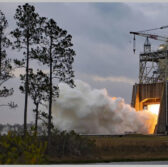As vice president of 5G.MIL® Programs at Lockheed Martin, Dan Rice oversees the strategy and performance of 5G and advanced communication technology solutions programs at the defense, aerospace and information security organization. Rice additionally handles the development and facilitation of strategic relationships as well as leads corporate independent research and development efforts.
Rice is a longtime Lockheed Martin team member, previously holding roles like vice president of technology strategy and research, vice president of operations and performance excellence and vice president of the company’s spatial solutions business. During the course of his career, the executive has earned four U.S. patents.
He recently conversed with ExecutiveBiz to explain Lockheed Martin’s 5G.MIL strategy and impress the importance of technology leadership to achieve U.S. global objectives, among other discussion points.
What can you tell us about the challenges facing federal networks and platforms as advanced technology impacts business practices in our industry and across other areas like the U.S. military and government agencies?
Today’s forces face fast-moving and sophisticated threats. It takes a secure network of platforms, sensors, and command and control to detect, deter and defeat those threats. Lockheed Martin’s 21st Century Security vision includes taking the best of defense and commercial technology to make forces agile, adaptive and unpredictable, so they stay ready for any mission — today and for decades to come. Technologies such as 5G, artificial intelligence, distributed cloud computing and autonomy are highly sought after by our defense customers. Our nation’s commercial technology industry is leading the world in these technologies, and we are working with them to bring them into the defense realm. The future of defense innovation will be a combination of commercial and government-driven technology as well as large and small company innovation. It is not now, nor will it ever be an “either-or” activity. Rather, it will be the integration of the best technologies that will keep the U.S. out in front of its adversaries.
Lockheed Martin brings a deep understanding of our customers’ missions and is uniquely positioned to provide the connectivity bridge across all warfighting domains. Our 5G.MIL solutions create interoperability among military tactical, operational and strategic networks using open system gateway solutions that leverage commercial software defined networking, 5G telecommunications technology and military grade security practices. The resulting heterogeneous network unifies communications to enable Joint All Domain Command and Control for Joint All-Domain Operations, giving our military and allies interoperability that accelerates decision-making advantages in complex and contested environments.
The 5G.MIL Hybrid Base Station is the cornerstone of this secure “network-of-networks,” with hardware and software based on Department of Defense modular open system architecture and commercial open standards for unified communications. This approach enables multi-vendor interoperability. Lockheed Martin is also enhancing commercially available 5G technology with military-grade network and transmission security features while leveraging the global reach of 5G to expand access to a worldwide network.
Leveraging our industry experience, deep mission expertise and strategic commercial relationships, Lockheed Martin is positioned to help our customers field, scale and deploy this technology rapidly and affordably across all operational domains: land, sea, air, space and cyber.
As warfare continues to be influenced by IT modernization and other initiatives, what do you believe are the most significant capabilities that are being developed for the Army, Navy, etc. to ensure our warfighters have the emerging technologies and tools they need to protect themselves and our nation’s national security interests?
Fifth Generation communication systems bring more reliable, higher throughput and ultra-low-latency connectivity required for edge devices and platforms to fully harness the power of advanced cloud-to-edge processing solutions, including artificial intelligence-based applications. By integrating 5G with existing military communications and datalinks, warfighters can operate more effectively in communications-contested and denied environments. Lockheed Martin’s 5G.MIL solutions will provide our military and allies with adaptable, resilient and secure “network-of-networks” connectivity between tactical networks, private 5G networks and commercial communications systems across all domains. By enhancing advanced wireless commercial technologies for interoperability with current-to-future tactical military systems, 5G.MIL solutions will enable cohesive data flow among battlefield assets to ensure warfighters are always ready for what’s ahead.
The 5G.MIL approach uses four key features of 5G technology to create affordable “military-grade” communications that harness continuing innovations in commercial communications:
- Flexible, high-performance communication services.
- Integrated data processing “at the edge.”
- Software-defined networking that can be hosted on low-cost, commercial, off-the-shelf hardware.
- Globally accepted architectures and standards supported by a rich supplier base.
Creating ubiquitous communications with a global heterogenous network-of-networks drives artificial intelligence processing and operational decisions to the edge, reducing decision timelines for countering rising global threats. Heterogenous 5G-enabled networks also bolster resilience by providing link-diverse pathways for data transfer and reducing single points of failure.
We are focused on developing three key capabilities to enhance military operations: interoperability, resilience and shared situational awareness.
- Interoperability: The open architecture and standards approach of the 5G.MIL HBS will allow communications systems made by one contractor to discover, route data and interoperate seamlessly with systems made by another. These systems connect the various “.MIL” datalinks used by military platforms such as aircrafts, ships, satellites, ground vehicles or even individual service members by establishing rapid, secure, heterogenous networks leveraging 5G standards-based mesh backhaul over a variety of resilient defense and commercial links, including space-based data transport.
- Resilience: 5G.MIL will enable forces to take sensor data from any platform in a global theater and make it accessible to any shooter in the theater, regardless of how each connects to the hybrid network. Software defined networking solutions provide real time routing decisions based on link availability, quality of service and capacity within the hybrid network.
- Shared Situational Awareness: 5G.MIL connectivity will enable any authorized user or system to quickly access and disseminate mission-critical data, beyond line-of-sight, in the world’s most austere and contested environments and where terrestrial communications infrastructure may not exist.
How have recent partnerships been able to assist your company expand its position in the federal marketplace, drive innovation and new capabilities and ultimately help complete your company’s mission?
Lockheed Martin is leading the future of defense innovation through industry, academic and commercial partnerships to power an ecosystem that connects our customers with advanced technologies and systems for smarter, faster decision-making. Recognizing that defense innovation will be a combination of commercial and military technology, from both large and small companies, creating and growing enduring relationships is another key element of Lockheed Martin’s 21st Century Security vision.
Lockheed Martin has led integration and convergence of tactical communications (“.MIL”) in systems and platforms for decades. Our collaborations with Intel, Microsoft, Verizon, Red Hat, Keysight, Radisys and other leading mobile communications companies bring commercial technologies to 5G.MIL solutions. Collaborating with these commercial companies will help us quickly and affordably deliver advanced networking and secure 5G capabilities at the tactical edge. This new capability will create faster, safer and more affordable 21st Century Security solutions that will infuse immersive experiences and other advanced commercial technologies into the most capable defense systems.
Leveraging the enormous investments made by commercial industry in wireless technologies, mobile devices, edge compute, storage and networking for 5G, 6G and beyond helps us accelerate the development timeline for the DOD, deliver affordability and scalability and maintain open architectures to support multi-vendor interoperability. Our open architecture and standards approach is designed for the inclusion and interoperability of current and future wireless connectivity technologies to facilitate seamless, future-proof, all-domain connectivity solutions for DOD challenges.
Lockheed Martin is leading the effort to bring enduring DOD communication systems together with military-hardened 5G to enable JADO anywhere in the world and is continuing to explore commercial collaborations to accelerate other needs for the DOD.





